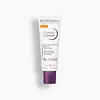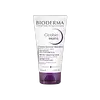What's inside
What's inside
 Key Ingredients
Key Ingredients

 Benefits
Benefits

 Concerns
Concerns

 Ingredients Side-by-side
Ingredients Side-by-side

Water
Skin ConditioningDiethylhexyl Butamido Triazone
UV AbsorberDicaprylyl Carbonate
EmollientDiisopropyl Sebacate
EmollientPropanediol
SolventButyl Methoxydibenzoylmethane
UV AbsorberCorn Starch Modified
AbsorbentBis-Ethylhexyloxyphenol Methoxyphenyl Triazine
Skin ConditioningPolyglyceryl-6 Stearate
EmollientDiethylamino Hydroxybenzoyl Hexyl Benzoate
UV FilterDibutyl Adipate
EmollientEthylhexyl Triazone
UV AbsorberButylene Glycol
HumectantPentylene Glycol
Skin ConditioningXylose
HumectantC20-22 Alkyl Phosphate
EmulsifyingC20-22 Alcohols
Emulsion StabilisingMicrocrystalline Cellulose
AbsorbentGlyceryl Caprylate
EmollientSqualane
EmollientPolyglyceryl-6 Behenate
Emulsion StabilisingSodium Polyglutamate
HumectantPolyacrylate Crosspolymer-6
Emulsion StabilisingSodium Citrate
BufferingXanthan Gum
EmulsifyingDipalmitoyl Hydroxyproline
Skin ConditioningSodium Hyaluronate
HumectantO-Cymen-5-Ol
AntimicrobialMannitol
HumectantRhamnose
HumectantXylitol
HumectantSodium Hydroxide
BufferingAcetyl Dipeptide-1 Cetyl Ester
Skin ConditioningGlabridin
BleachingTocopherol
AntioxidantFructooligosaccharides
HumectantPropylheptyl Caprylate
EmollientWater, Diethylhexyl Butamido Triazone, Dicaprylyl Carbonate, Diisopropyl Sebacate, Propanediol, Butyl Methoxydibenzoylmethane, Corn Starch Modified, Bis-Ethylhexyloxyphenol Methoxyphenyl Triazine, Polyglyceryl-6 Stearate, Diethylamino Hydroxybenzoyl Hexyl Benzoate, Dibutyl Adipate, Ethylhexyl Triazone, Butylene Glycol, Pentylene Glycol, Xylose, C20-22 Alkyl Phosphate, C20-22 Alcohols, Microcrystalline Cellulose, Glyceryl Caprylate, Squalane, Polyglyceryl-6 Behenate, Sodium Polyglutamate, Polyacrylate Crosspolymer-6, Sodium Citrate, Xanthan Gum, Dipalmitoyl Hydroxyproline, Sodium Hyaluronate, O-Cymen-5-Ol, Mannitol, Rhamnose, Xylitol, Sodium Hydroxide, Acetyl Dipeptide-1 Cetyl Ester, Glabridin, Tocopherol, Fructooligosaccharides, Propylheptyl Caprylate
Water
Skin ConditioningButylene Glycol
HumectantGlycerin
HumectantCaprylic/Capric Triglyceride
MaskingButyrospermum Parkii Butter
Skin ConditioningGlyceryl Stearate
EmollientGlycol Palmitate
EmulsifyingSodium Polyacrylate
AbsorbentPentylene Glycol
Skin Conditioning1,2-Hexanediol
Skin ConditioningCaprylyl Glycol
EmollientDipalmitoyl Hydroxyproline
Skin ConditioningMannitol
HumectantSodium Hyaluronate
HumectantXylitol
HumectantCitric Acid
BufferingRhamnose
HumectantSodium Citrate
BufferingAcetyl Dipeptide-1 Cetyl Ester
Skin ConditioningPolyquaternium-51
Skin ConditioningWater, Butylene Glycol, Glycerin, Caprylic/Capric Triglyceride, Butyrospermum Parkii Butter, Glyceryl Stearate, Glycol Palmitate, Sodium Polyacrylate, Pentylene Glycol, 1,2-Hexanediol, Caprylyl Glycol, Dipalmitoyl Hydroxyproline, Mannitol, Sodium Hyaluronate, Xylitol, Citric Acid, Rhamnose, Sodium Citrate, Acetyl Dipeptide-1 Cetyl Ester, Polyquaternium-51
Ingredients Explained
These ingredients are found in both products.
Ingredients higher up in an ingredient list are typically present in a larger amount.
Acetyl Dipeptide-1 Cetyl Ester is a peptide composed of amino acids arginine and tyrosine.
This peptide is considered a neurotransmitter peptide, meaning it has pain-relieving and relaxing properties. It has the ability to calm skin irritation from external factors such as chemical stinging or heat.
Neurotransmitter peptides are also often called "botox in a bottle". This is because these peptides have the ability to relax the muscles.
Though relaxing the muscles can prevent expression lines (as we have seen in botox), the studies do not show these peptides to be a botox replacement. The effects of this muscle relaxation is also short-term, as opposed to longer-term results from botox.
Learn more about Acetyl Dipeptide-1 Cetyl EsterButylene Glycol (or BG) is used within cosmetic products for a few different reasons:
Overall, Butylene Glycol is a safe and well-rounded ingredient that works well with other ingredients.
Though this ingredient works well with most skin types, some people with sensitive skin may experience a reaction such as allergic rashes, closed comedones, or itchiness.
Learn more about Butylene GlycolDipalmitoyl Hydroxyproline isn't fungal acne safe.
Mannitol is a sugar alcohol. It is a humectant and moisturizes the skin. In vitro (not tested on a living organism), mannitol displays antioxidant properties.
When found in aqueous solutions, mannitol tends to become acidic. This is because it loses a hydrogen ion. This is why mannitol can often be found with pH adjusting ingredients, such as sodium bicarbonate.
Fun fact: Mannitol can be found in foods as a sweetener. It can be naturally found in mushrooms, algae, fruits, and veggies.
Learn more about MannitolPentylene glycol is typically used within a product to thicken it. It also adds a smooth, soft, and moisturizing feel to the product. It is naturally found in plants such as sugar beets.
The hydrophilic trait of Pentylene Glycol makes it a humectant. As a humectant, Pentylene Glycol helps draw moisture from the air to your skin. This can help keep your skin hydrated.
This property also makes Pentylene Glycol a great texture enhancer. It can also help thicken or stabilize a product.
Pentylene Glycol also acts as a mild preservative and helps to keep a product microbe-free.
Some people may experience mild eye and skin irritation from Pentylene Glycol. We always recommend speaking with a professional about using this ingredient in your routine.
Pentylene Glycol has a low molecular weight and is part of the 1,2-glycol family.
Learn more about Pentylene GlycolWe don't have a description for Rhamnose yet.
Sodium Citrate is the sodium salts of citric acid. In skincare, it is used to alter pH levels and acts as a preservative.
Its main functions are to maintain the pH of a product and neutralize metal ions.
The acidity of our skin is maintained by our glands and skin biome; normal pH level of skin is slightly acidic (~4.75-5.5).
Being slightly acidic allows our skin to create an "acid mantle". This acid mantle is a thin barrier that protects our skin from bacteria and contaminants.
Learn more about Sodium CitrateSodium Hyaluronate is hyaluronic acid's salt form. It is commonly derived from the sodium salt of hyaluronic acid.
Like hyaluronic acid, it is great at holding water and acts as a humectant. This makes it a great skin hydrating ingredient.
Sodium Hyaluronate is naturally occurring in our bodies and is mostly found in eye fluid and joints.
These are some other common types of Hyaluronic Acid:
Learn more about Sodium HyaluronateWater. It's the most common cosmetic ingredient of all. You'll usually see it at the top of ingredient lists, meaning that it makes up the largest part of the product.
So why is it so popular? Water most often acts as a solvent - this means that it helps dissolve other ingredients into the formulation.
You'll also recognize water as that liquid we all need to stay alive. If you see this, drink a glass of water. Stay hydrated!
Learn more about WaterXylitol is a humectant and prebiotic. It can help with dry skin.
In studies, xylitol has been shown to improve dry skin. It decreased transepidermal water loss, or when water passes through the skin and evaporates. Xylitol also showed to help improve the biomechanical properties of the skin barrier.
The prebiotic property of xylitol may also help reinforce our skin's natural microbiome. Having a healthy microbiome prevents infection by bad bacteria and helps with hydration.
As a humectant, Xylitol helps draw moisture from both the air and from deeper skin layers. This helps keep skin hydrated.
Xylitol is a sugar alcohol and commonly used as a sugar substitute. It is naturally occurring in plants such as strawberries and pumpkin.
Learn more about Xylitol